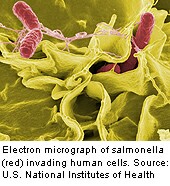
TUESDAY, June 9, 2015 (HealthDay News) — Antibiotic resistance in foodborne germs remains a public health threat despite attempts to combat the problem, according to new U.S. government data.
Antibiotic-resistant infections from foodborne germs still cause about 440,000 illnesses in the United States each year, the U.S. Centers for Disease Control and Prevention reported online Tuesday.
“Antibiotic resistance can arise spontaneously, but the greatest contribution to antibiotic resistance is the overuse and overprescribing of antibiotics,” said one expert, Dr. Len Horovitz, an internist at Lenox Hill Hospital in New York City. He was not involved in the new report.
Testing in 2013 revealed that multidrug resistance — non-responsiveness to three or more classes of antibiotics — in salmonella infections remained steady, accounting for 10 percent of foodborne illnesses, the CDC said.
But antibiotic resistance in some types of salmonella is increasing. In one strain, the rate of drug resistance more than doubled in two years, the agency said.
Salmonella infection causes diarrhea, fever and abdominal cramps.
Another foodborne germ monitored for drug resistance is campylobacter. In 2013, one-quarter of campylobacter samples from sick people were resistant to quinolone antibiotics such as ciprofloxacin, the agency said.
To curb drug-resistant infections, efforts are being made to reduce inappropriate use of antibiotics in food-producing animals.
Measuring the success of those efforts, the National Antimicrobial Resistance Monitoring System each year tracks changes in the antibiotic resistance of six common types of foodborne germs found in food animals, retail meats and ill people.
For the current report, the CDC investigators tested more than 5,000 foodborne germs from sick people and compared them with findings from previous years.
The investigators found that multidrug resistance in a common strain of salmonella called I4,[5],12:i:- rose from 18 percent in 2011 to 46 percent in 2013. Illness with this strain of salmonella has been linked to animal exposure and consumption of contaminated pork or beef.
None of this came as a surprise to Horovitz.
“Resistant strains of bacteria have already been identified repeatedly in hospital settings,” he said, “and this is just one more example of the genesis of antibiotic resistance.”
In most cases, people with salmonella or campylobacter infections have diarrhea that ends within a week without antibiotic treatment. However, the germs can also cause infection of the bloodstream and other sites in the body.
In serious infections and when germs are resistant, antibiotics may be ineffective, putting people at increased risk for severe illness, the CDC said.
More information
The U.S. Centers for Disease Control and Prevention has more about antibiotic resistance.
Copyright © 2025 HealthDay. All rights reserved.

